Winter Audio Reference: On-Board, Consumer, and Pro Solutions
by Derek Wilson on February 3, 2005 12:05 AM EST- Posted in
- Smartphones
- Mobile
The Cards
These are the first cards that we'll be taking a look at in their categories. Other sound hardware reviews that we do will have a point of reference to this article. For onboard solutions, we'll compare against the Realtek HD audio that we're reviewing today. When we look at consumer level add-in cards, the obvious metric is the Sound Blaster Audigy 2. For professional cards, we've chosen the Echo Audio Gina3g as our point of reference for its mix of features and solid quality.
The Intel, Gina3G, and Creative mix touches on high quality, integrated, multitrack/music recording, gaming, and the consumer audio solutions. We wanted to hit all these groups in this review in order to get a feel for what each had to offer. The first solution that we'll look at is the Intel solution.
Realtek Intel HD Audio
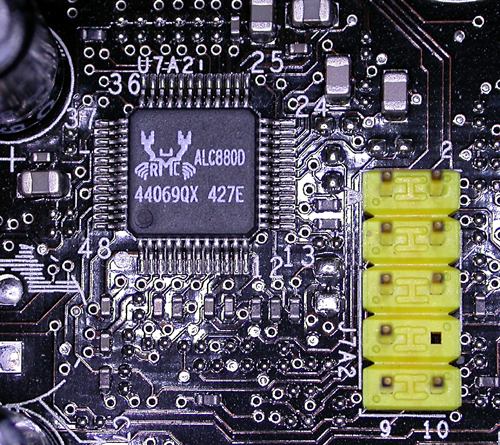
This is the Realtek Intel HD Audio codec chip.
As we can see, the Intel solution is the Realtek solution. We wanted to track down the DACs and opamps that drive the output, but finding these tiny chips on a motherboard proved too difficult a task for us. Suffice it to say that layout is key when dealing with an onboard solution. We actually plugged our Audigy in a PCI port further away from the video card, thinking we'd get better signal quality and noticed an 8dB increase in noise due to this:

This is a 1.5A low dropout positive regulator near the 3rd PCI slot on the 925XE board.
Imagine the difficulty in guarding against noise with an onboard solution if simply moving to a different PCI slot can change so much. Vendors other than Realtek are planning on coming out with HD audio compatible onboard solutions, and we are looking forward to testing those as well.
On the downside, the Realtek only has 20 bit stereo inputs, so doing a 24bit loopback is a little less than honest. The record quality of this onboard solution is less than optimal, and in very loud playback, a little noise can be heard.
Echo Audio Gina3G
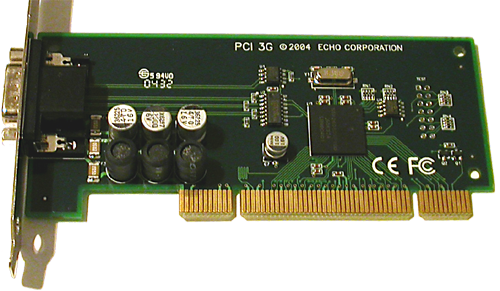
The Gina3G PCI card
The Gina3g is an entry level professional sound card from Echo Audio. Musicians on a budget are always on the lookout for a device that combines a few high quality analog inputs with a couple of coax and optical digital connections that support S/PDIF and ADAT I/O.
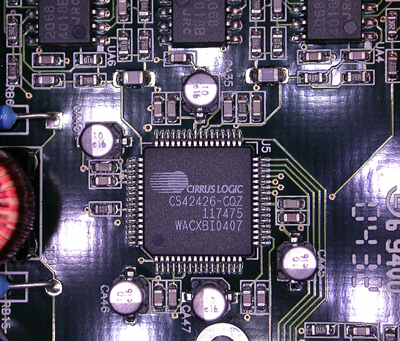
Inside the Gina3G breakout Box
This device would be a stop off on the way to something like the Lynx TwoB, or a DigiDesign ProTools solution. With the ability to record 8 digital channels at a time, 6 (highly configurable, balanced) analog outputs, and 2 universal analog inputs (accepts ¼ inch and XLR, balanced or unbalanced, and can provide 48v of phantom power), the Gina3g is targeted squarely at the end user looking to take their audio and put it on the PC. A small home studio could go the way of having a couple of rack mount devices - compressors, eqs, and an A/D - to bundle it all up and send it to the PC. The Gina would fit in nicely. There are both cheaper and more expensive solutions out there.
In any case, the reason why we are testing the Gina3g today is because its older siblings have done very well traditionally in terms of analog signal quality. We wanted to find out if Echo Audio's latest in the series still stacks up.
Creative SoundBlaster Audigy 2 ZS Platinum Pro
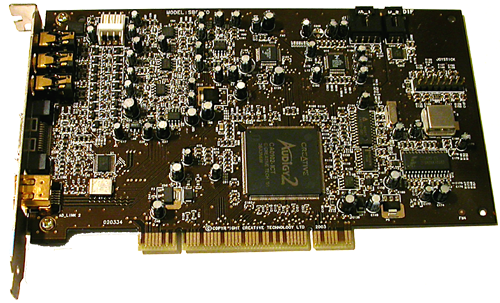
SoundBlaster Audigy 2 ZS Platinum Pro PCI Card
The Audigy is the consumer standard in sound hardware today. It is a very gamer and entertainment PC oriented solution. The Platinum Pro is a Swiss army knife of a sound card - a little of everything, but never exactly what you want. Digital playback is quality, but analog at 16-bit/44.1 kHz leaves something to be desired. Recording quality is solid, but there could be more I/O on the device if it is going to fit into any aggressive user's workflow. Lacking balanced analog I/O is a large oversight if Creative wanted to target the prosumer/audiophile. But in the end, the audigy does fit into just about every niche in which you could want a sound card. And it offers EAX Advanced HD as only Creative cards can.
Creative SoundBlaster Audigy 4 Pro
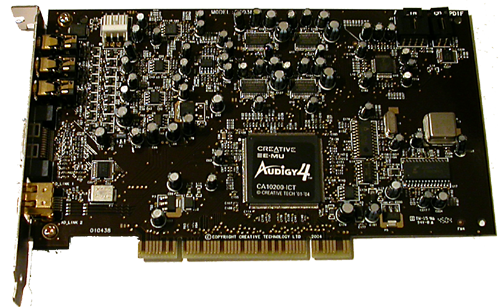
SoundBlaster Audigy 4 Pro
The SoundBlaster Audigy 4 Pro is basically an upgraded and massaged version of the Audigy 2 ZS Platinum Pro. The differences are in the quality of the DACs and ADCs used, some layout changes, and just a bit of a polish that makes the quality of the card fit the feature set better. Still offering the same gaming quality, the analog output of the card is now on par with professional level cards in some respects.
Summarizing the Differences
So, what are the key factors that are different among the contenders? Let's take a look:
-- DAC quality: the Audigy 4 has the highest quality DACs, though the Gina3G places it's DACs outside the PC in its breakout box. Here are the DACs used on the Audigy and Gina3G:
Audigy 2 DAC: 1x CS4382: 8out 114dB dynamic range, -100dB THD+N
Audigy 4 DAC: 4x CS4398: 2out 120dB dynamic range, -107dB THD+N
Gina3G DAC: 1x CS42426: 2in/6out 114dB dynamic range, -100dB THD+N
Both Audigy products use 4558c opamps with THD < .008%
Gina3G uses NJM2068 opamps with THD < .001%
-- Input quality: The Gina3G uses balanced I/O, and has the most input options. The quality of the ADCs on the Gina3G and Audigy are similar (Audigy is noisier with less THD). The Intel Audio solution only supports recording at a max of 20-bit/96kHz analog, and is noisy on recording. No pro digital recording features are enabled on the onboard solution even when lightpipe is present, so Creative and Echo have the Intel beat in digital recording as well.
-- Gaming features: The Creative solutions offer EAX 4.0 Advanced HD, which neither of the other cards can claim. Intel is able to include EAX 2.0 support along side it's DS3D and A3D support, but the Gina3G offers zero 3D hardware support or reverb API support. Included on the Gina3G is a DSP that is capable of such operations (Xilinx Spartan), but it's obviously intended for professional applications.
Other than that, the differences are in feature set and drivers. The Audigy cards offer the most in terms of "stuff" with their cards, though the Intel solution does a good job of filling in the gaps as well. Even though the Gina3G "only" supports 6-channel out on the consumer side, the fact that all 6 outputs are balanced TRS ¼ inch is a nice bonus for the musician. Depending on implementation, the Realtek solution can have optical and coax output, but Audigy and Gina3G both offer optical and coax in and out.










89 Comments
View All Comments
DerekWilson - Thursday, February 3, 2005 - link
Sorry for the confusion guys,We had originally just picked on card from each end of the market (onboard, addin, pro) and then decided that we needed to do both the audigy 2 and 4 because they're so similar. It's really meant to be an intro piece on sound and a look at an example of each market segment.
We certainly weren't trying to be all inclusive, and we do want your feedback. These cards will be our "comparison point" cards in each market segment. When we look at onboards solutions, we'll talk about how it compares to the ALC880, and on the Pro side, we'll match up the Gina3G with whatever we're looking at.
And when we do a targeted review as for proaudio we will absolutely spend time setting up a workstation and running some latency tests and we'll talk about asio/gsif support more in depth.
We will be reviewing more sound cards :-)
We didn't want to review all of them at once and spoil the fun though. :-D
MarkM - Thursday, February 3, 2005 - link
I second #5's request -- esp concerning the onboard, which is more relevant for most new builds>on board nvidia audio would be interesting as well as an older sb live 5.1 card for reference
LoneWolf15 - Thursday, February 3, 2005 - link
Not a single card based on the VIA Envy24 setup...no M-Audio Revolution, no Terratec, no Chaintech AV-710 (all Envy24-based)...I can't believe Anandtech left one of the largest enthusiast chipsets out of the roundup. There's just not enough representation here of available solutions to make a good comparison, it's either Intel or Creative, and Intel isn't an option for AMD users.If you're going to make onboard comparisons, why not (even if it's a poor solution) add the ALC850 found on most Socket 754/939 boards, seeing as AMD users can't exactly get Intel/Azalia HD audio?
hondaman - Thursday, February 3, 2005 - link
More cards please!!! Soundstorm, older audigy/Live and m-audio sure would have made this article a whole lot better, as thats what a lot of people are using.bob661 - Thursday, February 3, 2005 - link
If mid-range cards are an order of magnitude better in objective sound tests than onboard solutions, I might actually go back to buying sound cards.I would like to reaquest testing the onboard Realtek's on the Athlon64 motherboards. I would be interested in seeing how they perform compared to mid-range and high-end sound cards.
EddNog - Thursday, February 3, 2005 - link
Yep; gotta' have at least a halfway decent setup, from head to tail. I'm pretty happy with my setup:foobar2000 kernel streaming FLAC/Monkey's Audio to
Echo Audio Mia MIDI with sample rate locked to 44.1, out via 75ohm impedance silver coax S/PDIF to
Onkyo TX-SR501, out via silver cabling to
a pair of Paradigm Studio/20 Rev. 3 sitting on
Atlantis Reference stands
"I'm lovin' it."
-Ed
OrSin - Thursday, February 3, 2005 - link
Most people are not gaming with 800 sound cards.I would be suprised if gamers are using $100 sound cards. When people list out thier RIGS 8 out 10 don't even lsit thier sound card. And the other 2 have $100 or less cards. I'm all for a review of $200+ cards but almost all are not using them for gaming.
Also in order to hear better sound from $100+ card you need a better and better speak system. Not just speaker, but a good in home setup. I threw down $1000 on a speak system and it sound ok. WhenI had my friend come over and setup it up right. It sounded great. It more then just buying them and plugging them in. It take a lot to get a quailty setup. High end sound cards only will not do it, so for some it just not worth going beyond a $100 card.
Araemo - Thursday, February 3, 2005 - link
[Self-serving]Could we get an onboard audio review for the Soundstorm on the Abit NF7-S v2? ;P[/self-serving]
Seriously though, good review.. but I'd like to know where my current system stands.
And does anybody know how much "THX Certified" is worth? I have logitech Z-2200s connected to my nForce onboard right now(My Audigy developed an odd crackling noise during gameplay that I couldn't get rid of.)
yodel - Thursday, February 3, 2005 - link
YellowWing - Thursday, February 3, 2005 - link
What about AC3 digital encode? The next PC I build will be a HTPC, and digital encode for a single connection to my receiver is of great importance. I doubt if any of the sound systems analog sections would be used.What is the overhead of the digital encode? Does it slow a frame rate or not seem to matter?
Can you hear the difference between the digital and analog output with a good home theater setup?